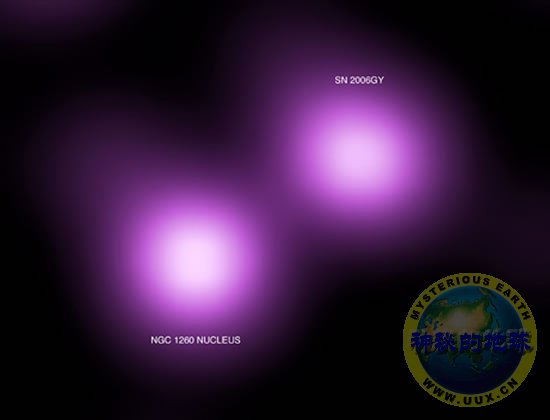Competing Theories Proposed for Superbright Supernova
An x-ray image taken by NASA's Chandra X-ray Observatory reveals supernova 2006gy (left) shining as bright as the nucleus of its galaxy.
This puzzling brilliance has led scientists to propose two unusual formation mechanisms: a collision between two massive stars or a single, repeatedly exploding star.
Image courtesy NASA/CXC/UC Berkeley/N.Smith et al.
Anne Minard
for National Geographic News
November 14, 2007
Two teams of researchers have proposed competing explanations for one of the most brilliant—and puzzling—supernovas in the observable universe, 2006gy.
Burning 240 million light-years away in the constellation Perseus, the stellar explosion has baffled scientists since it was spotted more than a year ago, because it is at least ten times too bright to have come from the routine collapse of a star's core.
One of the studies, led by Simon Portegies Zwart of the University of Amsterdam in the Netherlands, proposes that the supernova was created during a collision between two massive stars.
The other paper, led by Stan Woosley at the University of California, Santa Cruz, suggests that the supernova arose from collisions between shells of matter exploding sequentially out of a single, supermassive star.
Both papers appear in this week's issue of the journal Nature.
Stellar Smash-Up
To have caused a supernova of the observed size, 2006gy would have to have been a real giant—a hundred or more times the mass of the sun—according to Portegies Zwart and co-author Edward P.J. van den Huevel of the University of Amsterdam and the University of California, Santa Barbara.
But there's too much hydrogen in the supernova's chemical signature to endorse that scenario, the researchers point out. Stars more than 40 solar masses shed their hydrogen envelopes long before they explode.
2006gy, however, occurs near the center of its galaxy, where frequent stellar collisions could create an unusually massive star.
One scenario best explains 2006gy's unusual brightness and the presence of hydrogen in the supernova and the space around it, the researchers say.
A star a hundred times as massive as the sun—in the final phases of depleting the hydrogen in its core—collided with a hydrogen-rich sunlike star of 10 to 40 solar masses.
The smaller, younger star would have infused the old star with hydrogen tens or hundreds of thousands of years before the onset of its fiery death throes, explaining the hydrogen that remained afterwards.
If that's right, the researchers say, a dense cluster of massive stars will become visible at the site of the explosion when 2006gy fades in a year or so.
Dying Alone
The alternate model proposed by Woosley and his colleagues has the spectacular clash happening not between multiple stars but between remnants of sequential, explosive pulses from a single dying star.
As such a massive star's life neared the end, it would have entered a phase of burning that was insufficient to fully incinerate its core. But the burning would have been strong enough to cause explosions that ejected out shells of material many times the mass of our sun, the researchers say.
The core would then have contracted, regrouped, and exploded again. The new explosion would have released massive amounts of material, which would have collided with matter from the first explosion.
Such a bombardment could explain the extraordinarily bright display in 2006gy, Woosley said. He and his colleagues have dubbed it a "hypernova."
"Our model is in good agreement with the observed light curve for SN 2006gy and also shows that some massive stars can produce more than one supernova-like outburst," Woosley and his colleagues wrote.
Enduring Mystery
Both theories are mere speculation for now—but that may change as 2006gy clears up over the years.
Both sets of researchers, for example, say the supernova could eventually collapse into a black hole equally impressive in its mass.
Woosley also suggests, however, that if 2006gy didn't burn up its entire helium core during this explosion, it may regroup and explode again.
He said that the other paper "calculates no light curve, so it is only a speculation about how a progenitor star may have formed."
Most massive stars are born and die in clusters, he added, so if a cluster is visible after 2006gy fades, that's not necessarily evidence that the two-star collision model is best.
Portegies Zwart said the jury is still out on which explanation rings truer.
"To what extent the two theories are really consequences of each other, and if they really explain the same phenomenon in the end is hard to say," he pointed out.
"But I'm sure more research will be done in this direction."












